Whatever You Say, Dear
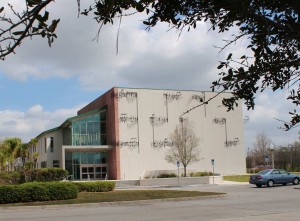 Jutting from the south wall of the Bower School of Music are 11 musical staves brimming with duplets, triplets and other notes. Made of powder-coated laser cut aluminum plate, the musical notation is a wall sculpture titled Whatever You Say, Dear created for Florida Gulf Coast University by West Palm Beach public artist Mark Fuller.
Jutting from the south wall of the Bower School of Music are 11 musical staves brimming with duplets, triplets and other notes. Made of powder-coated laser cut aluminum plate, the musical notation is a wall sculpture titled Whatever You Say, Dear created for Florida Gulf Coast University by West Palm Beach public artist Mark Fuller.
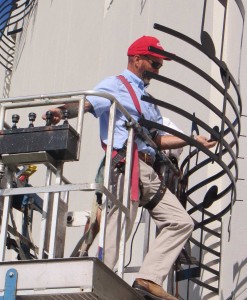 Each staff stands 2.5 feet tall and holds an assortment of clefs and notes that range from 30 to 36 inches high. Fuller has mounted each staff several inches off the wall in order to accentuate the deep shadows they cast, which strengthen and fade during the course of the day as they interact with the natural light. But on top of that, Fuller has strategically arranged the staves so that they appear to be coming out of the architectural recesses and indentations designed into the building’s facade, visually reinforcing the idea that music emanates from inside as students and faculty practice and perform within.
Each staff stands 2.5 feet tall and holds an assortment of clefs and notes that range from 30 to 36 inches high. Fuller has mounted each staff several inches off the wall in order to accentuate the deep shadows they cast, which strengthen and fade during the course of the day as they interact with the natural light. But on top of that, Fuller has strategically arranged the staves so that they appear to be coming out of the architectural recesses and indentations designed into the building’s facade, visually reinforcing the idea that music emanates from inside as students and faculty practice and perform within.
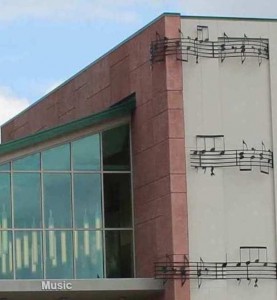 States the dedication for Whatever You Say, Dear, “Mr. Fuller shares his flare for fun and whimsy, while successfully capturing a stated goal for the project – ‘to show the first time visitor that this is the music building.'” But the sculptor adds with characteristic self-deprecation, “I can’t read music; my girlfriend is an opera singer; and I don’t speak much Italian. Her voice is like music to my ears, so I titled this piece in pun to reflect my lack of understanding of what she sings, how she thinks, or what this stave might actually sound like.”
States the dedication for Whatever You Say, Dear, “Mr. Fuller shares his flare for fun and whimsy, while successfully capturing a stated goal for the project – ‘to show the first time visitor that this is the music building.'” But the sculptor adds with characteristic self-deprecation, “I can’t read music; my girlfriend is an opera singer; and I don’t speak much Italian. Her voice is like music to my ears, so I titled this piece in pun to reflect my lack of understanding of what she sings, how she thinks, or what this stave might actually sound like.”
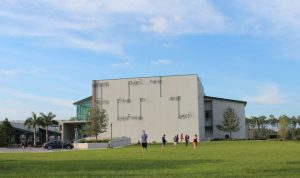 Completed on May 31, 2011, Whatever You Say, Dear is part of the Florida Art in Public Buildings program, an initiative started in 1979 pursuant to section 255.043 of the Florida Statutes, which earmarks 0ne-half of one percent of the amount the legislature appropriates for the construction of state buildings for the acquisition of public artworks.
Completed on May 31, 2011, Whatever You Say, Dear is part of the Florida Art in Public Buildings program, an initiative started in 1979 pursuant to section 255.043 of the Florida Statutes, which earmarks 0ne-half of one percent of the amount the legislature appropriates for the construction of state buildings for the acquisition of public artworks.
About Mark Fuller
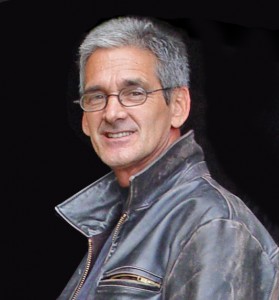 An environmental graphic and industrial designer, Mark Fuller has been creating dynamic site specific sculptural installations for a wide variety of public art programs since 1992. “I specialize in the design and fabrication of contemporary public art installations,” says Mark, “and my work for Art in Public Places programs can be found in all four corners of the country.”
An environmental graphic and industrial designer, Mark Fuller has been creating dynamic site specific sculptural installations for a wide variety of public art programs since 1992. “I specialize in the design and fabrication of contemporary public art installations,” says Mark, “and my work for Art in Public Places programs can be found in all four corners of the country.”
Fuller’s monumental work has been oriented primarily towards creating site-specific sculptural elements that help to establish a strong sense of place. In addition to 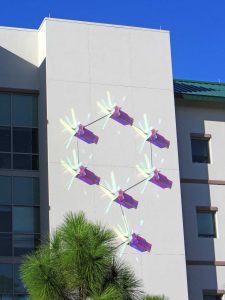 his public art, his experience as an industrial designer includes urban street furniture such as seating elements, bollards, lighting fixtures, tree grates and telephone kiosks. His Art In Public Places installations have included kinetic constructions, compression-tension cable structures and static free-standing elements.
his public art, his experience as an industrial designer includes urban street furniture such as seating elements, bollards, lighting fixtures, tree grates and telephone kiosks. His Art In Public Places installations have included kinetic constructions, compression-tension cable structures and static free-standing elements.
Fuller’s work is not predictable, nor can it be characterized by a specific look. Rather, it is highly stylized by his research into the unique function, architecture, environmental and cultural aspects that surround each project . As a result, the visual characteristics of Fuller’s installations flex and change with an appropriate sensitivity for the project at hand. His works are site-specific, and typically 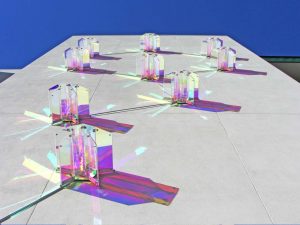 laced with symbolic or abstract references that link the art solidly to it’s environment. “My installations are typically colorful, playful, and site specific,” Fuller remarks. The National Endowment For The Arts concurs, calling his work “a good example of what public art can be.”
laced with symbolic or abstract references that link the art solidly to it’s environment. “My installations are typically colorful, playful, and site specific,” Fuller remarks. The National Endowment For The Arts concurs, calling his work “a good example of what public art can be.”
Fuller is a pioneer in creating installations that utilize cutting edge solar-generated electric power, LED 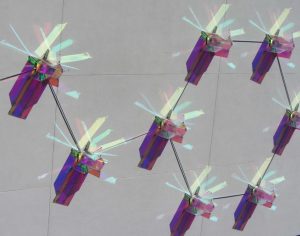 luminaries and recycled glass waste materials. His most recent work, such as Depend du Soleil, also explores the use of cutting edge high-tech dichroic coatings (see below). With an interest in promoting ‘green,’ low-carbon-footprint ideology, Mark continues to move forward developing appropriate eco-conscious fabrication methods and techniques.
luminaries and recycled glass waste materials. His most recent work, such as Depend du Soleil, also explores the use of cutting edge high-tech dichroic coatings (see below). With an interest in promoting ‘green,’ low-carbon-footprint ideology, Mark continues to move forward developing appropriate eco-conscious fabrication methods and techniques.
Other Fuller Public Art Installations
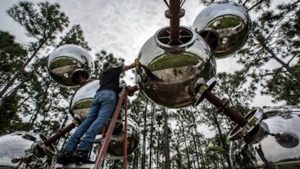 While Mark Fuller’s public art pieces have been installed nationwide, Palm Beach Gardens has the most. In furtherance of its motto of “Live, Learn, Work and Play,” Palm Beach Gardens has dedicated 30% of its land to green space, created recreation programs tailored to residents of all ages, and built an award-winning Art in Public Places
While Mark Fuller’s public art pieces have been installed nationwide, Palm Beach Gardens has the most. In furtherance of its motto of “Live, Learn, Work and Play,” Palm Beach Gardens has dedicated 30% of its land to green space, created recreation programs tailored to residents of all ages, and built an award-winning Art in Public Places 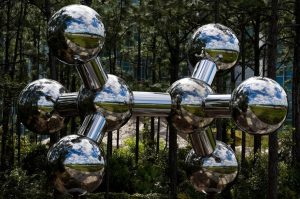 program that fosters a pro-active business climate that embraces innovation and an intrinsic understanding of the balance between social and economic conditions. That program has commissioned Fuller to create more than two dozen public art installations.
program that fosters a pro-active business climate that embraces innovation and an intrinsic understanding of the balance between social and economic conditions. That program has commissioned Fuller to create more than two dozen public art installations.
Stack 45 is a work that exemplifies the symbolic imagery 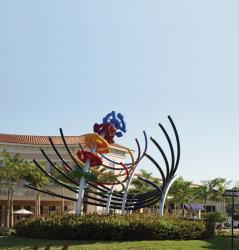 typically found in a Fuller public artwork. It is a poignant tribute to urban designer Hank Skokowski, the city planner who designed PGA National, Ballen Isles and Palm Beach Gardens’ Legacy Place, a mixed use center located on PGA Boulevard and A1A that contains 469,000 square feet of retail space. Fuller’s best friend, Hank died tragically in a motorcycle accident in Australia shortly after completing Legacy Place. “Hank was weaned on 45s,” Fuller explains of the piece, whose five black outer semi-circular rings represent vinyl records
typically found in a Fuller public artwork. It is a poignant tribute to urban designer Hank Skokowski, the city planner who designed PGA National, Ballen Isles and Palm Beach Gardens’ Legacy Place, a mixed use center located on PGA Boulevard and A1A that contains 469,000 square feet of retail space. Fuller’s best friend, Hank died tragically in a motorcycle accident in Australia shortly after completing Legacy Place. “Hank was weaned on 45s,” Fuller explains of the piece, whose five black outer semi-circular rings represent vinyl records 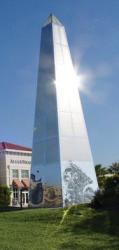 and whose five colored inner circles symbolize the records’ labels. The piece is located in the center of a traffic circle, “metaphorically, a turntable,” Fuller notes. Fuller included five of each element in his piece to signify that Hank was but 55 when he died. “The semi-circular rings are arced back; a symbolic gesture of arms opened to the heavens.”
and whose five colored inner circles symbolize the records’ labels. The piece is located in the center of a traffic circle, “metaphorically, a turntable,” Fuller notes. Fuller included five of each element in his piece to signify that Hank was but 55 when he died. “The semi-circular rings are arced back; a symbolic gesture of arms opened to the heavens.”
One of Fuller’s best known works is Obelisk (right), a gleaming 36′ foot tall spire on PGA Boulevard at Legacy Place. The piece features a mirror-polished stainless steel skin studded with 89,986 custom-made clear glass marbles that catch, refract and reflect the sunlight. “Stop by in the daylight and it’s a mirror, reflecting the Australian pines across 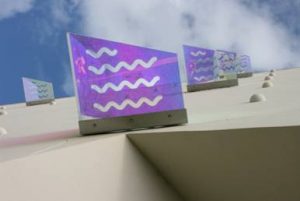 the way, one of the city’s countless pink Mediterranean buildings and the PGA flyover,” writes Florida Weekly‘s Mary Jane Fine. “Stop by at night and the computer mechanism tucked inside performs a six-minute-long light show capable of painting the piece, Mr. Fuller says, with 12 million different colors.”
the way, one of the city’s countless pink Mediterranean buildings and the PGA flyover,” writes Florida Weekly‘s Mary Jane Fine. “Stop by at night and the computer mechanism tucked inside performs a six-minute-long light show capable of painting the piece, Mr. Fuller says, with 12 million different colors.”
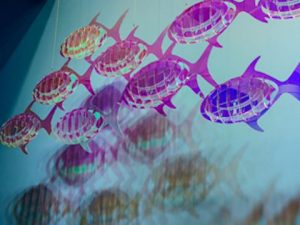 Just down the road in Delray Beach is a work that bears some resemblance to Depend du Soleil. Its name is Light Swimming (ded. 11-28-2007) and it was crafted for the South County Civic Center as part of Palm Beach County’s Art in Public Places program. Like Depend du Soleil, it is an ever-changing light display on the building’s west and south facades. Light Swimming is a shapeshifter whose colors and shadows transmute with the sun’s position
Just down the road in Delray Beach is a work that bears some resemblance to Depend du Soleil. Its name is Light Swimming (ded. 11-28-2007) and it was crafted for the South County Civic Center as part of Palm Beach County’s Art in Public Places program. Like Depend du Soleil, it is an ever-changing light display on the building’s west and south facades. Light Swimming is a shapeshifter whose colors and shadows transmute with the sun’s position 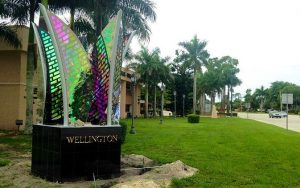 in the sky and the viewer’s perspective as they walk or drive by. Depending on the time of day and sunlight’s intensity, it may bathe the civic center’s exterior walls in brilliant pinks, purples, blues and even hues of green. And like Depend du Soleil, Light Swimming also lights up at night thanks to solar-powered LED lights. Through
in the sky and the viewer’s perspective as they walk or drive by. Depending on the time of day and sunlight’s intensity, it may bathe the civic center’s exterior walls in brilliant pinks, purples, blues and even hues of green. And like Depend du Soleil, Light Swimming also lights up at night thanks to solar-powered LED lights. Through  the addition of dimensional hemispheres, the design further complements the civic center’s diagonal grid.
the addition of dimensional hemispheres, the design further complements the civic center’s diagonal grid.
Fuller also received considerable attention and deserved acclaim for Palm Beach Gardens Fire-Rescue Department 9.11.01 Memorial Plaza, which he designed pro bono around a three story section of steel  from the south tower of the World Trade Center that was bent due to the searing heat it was subjected to when the tower came down. The beam, which was located between the 12th and 15th floors of the south tower, is surrounded by benches and glass plaques etched with the names of the almost 3,000 victims of the attacks. “We put it straight up to show Americans are still standing strong,” proclaims Fuller, who was
from the south tower of the World Trade Center that was bent due to the searing heat it was subjected to when the tower came down. The beam, which was located between the 12th and 15th floors of the south tower, is surrounded by benches and glass plaques etched with the names of the almost 3,000 victims of the attacks. “We put it straight up to show Americans are still standing strong,” proclaims Fuller, who was 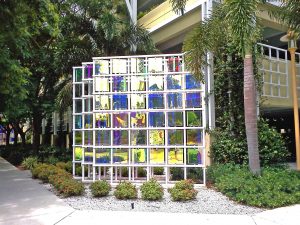 in New York City the day before the attacks. Four Palm Beach Gardens police officers and four Palm Beach Gardens firefighters escorted the flag-draped beam from JFK International Airport in New York to its new home outside the fire station.
in New York City the day before the attacks. Four Palm Beach Gardens police officers and four Palm Beach Gardens firefighters escorted the flag-draped beam from JFK International Airport in New York to its new home outside the fire station.
Closer to home, Fuller also crafted Cambier’s Quilt, the first public art project at a municipal building under the City of Naples’ public art ordinance. 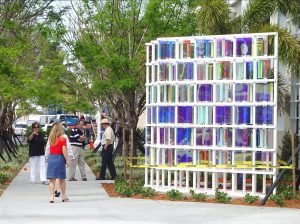 Sponsored by the Public Art Advisory Committee and city council, the installation consists of two structures that are nearly 12 feet tall and weigh 1,300 pounds. They each have 108 dicroic coated panels that pivot with the wind, changing color and reflecting the surroundings as they move. The piece is located at the new city parking garage, across from Cambier Park on Eight Street South,
Sponsored by the Public Art Advisory Committee and city council, the installation consists of two structures that are nearly 12 feet tall and weigh 1,300 pounds. They each have 108 dicroic coated panels that pivot with the wind, changing color and reflecting the surroundings as they move. The piece is located at the new city parking garage, across from Cambier Park on Eight Street South, 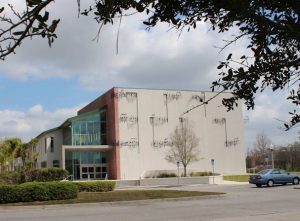 just south of Naples’ fabled Fifth Avenue South.
just south of Naples’ fabled Fifth Avenue South.
Depend du Soleil is one of two Mark Fuller works located at Florida Gulf Coast University. The other is titled Whatever You Say, Dear and is installed on the south facade of the Bower School of Music building. The latter piece uses light somewhat differently than Depend du Soleil. There, Fuller fashioned  musical notation using powder-coated laser cut aluminum plating. He suspended the staff several inches off the wall so that the duplets, triplets, flats and other musical notes will cast shadows against the building’s facade. Like its mathematical sister, Whatever You Say, Dear displays Fuller’s flair for the fun and whimsical.
musical notation using powder-coated laser cut aluminum plating. He suspended the staff several inches off the wall so that the duplets, triplets, flats and other musical notes will cast shadows against the building’s facade. Like its mathematical sister, Whatever You Say, Dear displays Fuller’s flair for the fun and whimsical.
Fast Facts.
- Mark Fuller was born in 1953 and has resided since 1988 in West Palm Beach, Florida.
- Whatever You Day, Dear cost $33,900.
- The sculpture extends 44 feet up the south facade of FGCU Academic Building #7 and is 23 feet wide.
Last Updated: June 21, 2018.
_____________________
Related Articles and Links.
Public artist Mark Fuller back in the news (06-19-17)
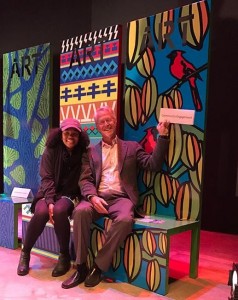 Public artist Mark Fuller is in the news again. An environmental graphic and industrial designer, Fuller has a presence in Southwest Florida with two public art pieces at Florida Gulf Coast University and another bordering Cambier Park in downtown Naples. More recently, the Delray Beach Public Art Advisory Board selected Fuller and Agata Ren as artists in residence for a city-wide art project that has culminated in the creation of fifteen 8-foot-tall by 2-foot-wide aluminum chairs painted in colorful emblematic themes by Agata Ren.
Public artist Mark Fuller is in the news again. An environmental graphic and industrial designer, Fuller has a presence in Southwest Florida with two public art pieces at Florida Gulf Coast University and another bordering Cambier Park in downtown Naples. More recently, the Delray Beach Public Art Advisory Board selected Fuller and Agata Ren as artists in residence for a city-wide art project that has culminated in the creation of fifteen 8-foot-tall by 2-foot-wide aluminum chairs painted in colorful emblematic themes by Agata Ren.
The project paired the artists with city and community leaders acting as 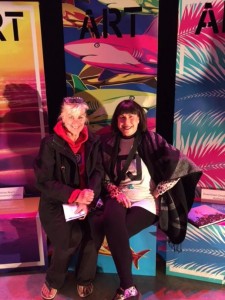 muses to inspire creative thinking CITYWIDE. The chairs are being placed thorough Delray. Each has the word ART cut out in the chair back and a QR code that directs visitors to the locations of the other 14 chairs.
muses to inspire creative thinking CITYWIDE. The chairs are being placed thorough Delray. Each has the word ART cut out in the chair back and a QR code that directs visitors to the locations of the other 14 chairs.
The project took approximately a year from call to realization.
Mark Fuller has been creating dynamic site specific sculptural installations for a wide variety of public art programs since 1992. “I specialize in the design and fabrication of contemporary public art installations,” says Mark, “and my work for Art in Public Places programs can be found in all four corners of the country.”
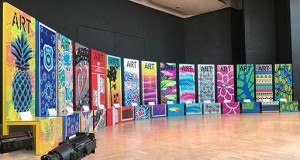 Fuller’s monumental work has been oriented primarily towards creating site-specific sculptural elements that help to establish a strong sense of place. In addition to his public art, his experience as an industrial designer includes urban street furniture such as seating elements, bollards, lighting fixtures,
Fuller’s monumental work has been oriented primarily towards creating site-specific sculptural elements that help to establish a strong sense of place. In addition to his public art, his experience as an industrial designer includes urban street furniture such as seating elements, bollards, lighting fixtures, 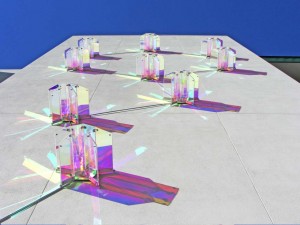 tree grates and telephone kiosks. His Art In Public Places installations have included kinetic constructions, compression-tension cable structures and static free-standing elements.
tree grates and telephone kiosks. His Art In Public Places installations have included kinetic constructions, compression-tension cable structures and static free-standing elements.
At FGCU, Fuller is responsible for Depend du Soleil on the south wall of Academic Building #7 and Whatever You Say, Dear on the south façade of the Bower School of Music building. Fuller also 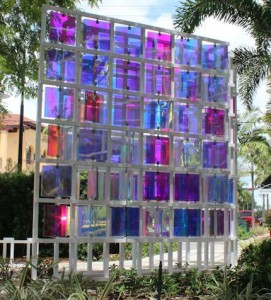 crafted Cambier’s Quilt, the first public art project at a municipal building under the City of Naples’ public art ordinance. Sponsored by the Public Art Advisory Committee and city council, the installation consists of two structures that are nearly 12 feet tall and weigh 1,300 pounds. They each have 108 dicroic coated panels that pivot with the wind, changing color and reflecting the surroundings as they move. The piece is located at the new city parking garage, across from Cambier Park on Eight Street South, just south of Naples’ fabled Fifth Avenue South.
crafted Cambier’s Quilt, the first public art project at a municipal building under the City of Naples’ public art ordinance. Sponsored by the Public Art Advisory Committee and city council, the installation consists of two structures that are nearly 12 feet tall and weigh 1,300 pounds. They each have 108 dicroic coated panels that pivot with the wind, changing color and reflecting the surroundings as they move. The piece is located at the new city parking garage, across from Cambier Park on Eight Street South, just south of Naples’ fabled Fifth Avenue South.














 Tom Hall is both an amateur artist and aspiring novelist who writes art quest thrillers. He is in the final stages of completing his debut novel titled "Art Detective," a story that fictionalizes the discovery of the fabled billion-dollar Impressionist collection of Parisian art dealer Josse Bernheim-Jeune, thought by many to have perished during World War II when the collection's hiding place, Castle de Rastignac in southern France, was destroyed by the Wehrmacht in reprisal for attacks made by members of the Resistance operating in the area. A former tax attorney, Tom holds a bachelor's degree as well as both a juris doctorate and masters of laws in taxation from the University of Florida. Tom lives in Estero, Florida with his fiancee, Connie, and their four cats.
Tom Hall is both an amateur artist and aspiring novelist who writes art quest thrillers. He is in the final stages of completing his debut novel titled "Art Detective," a story that fictionalizes the discovery of the fabled billion-dollar Impressionist collection of Parisian art dealer Josse Bernheim-Jeune, thought by many to have perished during World War II when the collection's hiding place, Castle de Rastignac in southern France, was destroyed by the Wehrmacht in reprisal for attacks made by members of the Resistance operating in the area. A former tax attorney, Tom holds a bachelor's degree as well as both a juris doctorate and masters of laws in taxation from the University of Florida. Tom lives in Estero, Florida with his fiancee, Connie, and their four cats.